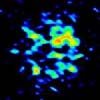| . |  |
. |
The beginnings of precious metals like gold can be traced to the blink of an eye in an exploding star billions of years ago, and scientists at the National Superconducting Cyclotron Laboratory (NSCL) at Michigan State University have been able to scrutinize a crucial step in that process. By reproducing the processes inside supernovas in a laboratory, scientists have resurrected an isotope of nickel � one that no longer exists in nature, but is an important link in the birth of the elements. "Every gold atom you find in the gold on your ring, every one of those atoms has gone through such a process," said Hendrik Schatz, an associate professor of physics at the NSCL. "We've now seen a link in the chain � one that controlled everything." Schatz will discuss these findings at the American Physical Society meeting in Tampa, Fla., Sunday. The isotope � nickel-78, or Ni-78 � shows up with the standard number of 28 protons, but with 50 neutrons. Because nickel must get rid of so many extra neutrons, this isotope is extremely unstable and does not exist in nature. But, Schatz explained, it did exist briefly in the chain of events that evolved into the elements. A collaboration of scientists from the United States and Germany at the NSCL recreated Ni-78 by whirling around a stable isotope of krypton gas until it reached high speeds and then firing it into a plate of beryllium metal. Because the NSCL is the nation's premier rare isotope accelerator, it's capable of shooting 100 billion krypton atoms a second. Even then, Ni-78 only shows up about twice a day. It would take less powerful accelerators years to run this sort of an experiment, Schatz explained. Ni-78 only exists for 110 milliseconds � that's a 10th of a second. Researchers at MSU haven't been the first to find Ni-78, but they've produced 11 occurrences of the isotopes, enough to finally derive its life span, said Paul Hosmer, a doctoral candidate working on the project. That's always been a missing piece of the puzzle, since the progressive decay of isotopes results in the synthesis of precious metals in exploding stars. Ni-78 has been found to be considerably quicker to decay � up to three times quicker. That changes the way scientists construct models of how elements were built before the Earth was formed some 4.5 billion years ago. Unlocking the secrets of Ni-78 is especially exciting to scientists because of a design quirk. Ni-78 is what researchers call "doubly magic." That means that its number of protons and number of neutrons are in a subatomically tidy package that makes it easier to study. Hosmer said it's like studying a bunch of cats and dogs. The groups are a lot easier to keep track of if they're in a pen. That, basically, is what being doubly magic is � an isotope with the protons and neutrons in defined pens. The 28 protons and 50 neutrons are more stable and less reactive when they're penned up. Related Links NSCL SpaceDaily Search SpaceDaily Subscribe To SpaceDaily Express  Manchester, UK (SPX) Apr 07, 2005
Manchester, UK (SPX) Apr 07, 2005Astronomers using the National Science Foundation's Very Large Array (VLA) radio telescope are taking advantage of a once-in-a-lifetime opportunity to watch an old star suddenly stir back into new activity after coming to the end of its normal life.
|
| ||||||||||
| The content herein, unless otherwise known to be public domain, are Copyright 1995-2016 - Space Media Network. All websites are published in Australia and are solely subject to Australian law and governed by Fair Use principals for news reporting and research purposes. AFP, UPI and IANS news wire stories are copyright Agence France-Presse, United Press International and Indo-Asia News Service. ESA news reports are copyright European Space Agency. All NASA sourced material is public domain. Additional copyrights may apply in whole or part to other bona fide parties. Advertising does not imply endorsement, agreement or approval of any opinions, statements or information provided by Space Media Network on any Web page published or hosted by Space Media Network. Privacy Statement All images and articles appearing on Space Media Network have been edited or digitally altered in some way. Any requests to remove copyright material will be acted upon in a timely and appropriate manner. Any attempt to extort money from Space Media Network will be ignored and reported to Australian Law Enforcement Agencies as a potential case of financial fraud involving the use of a telephonic carriage device or postal service. |